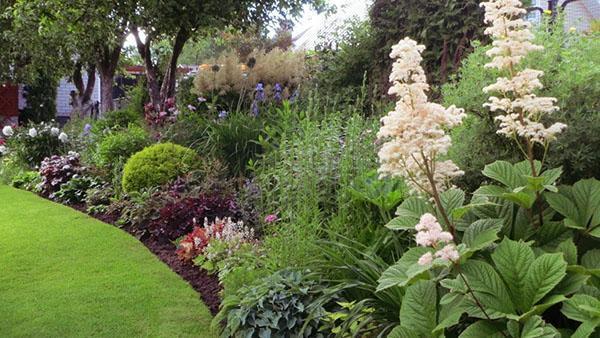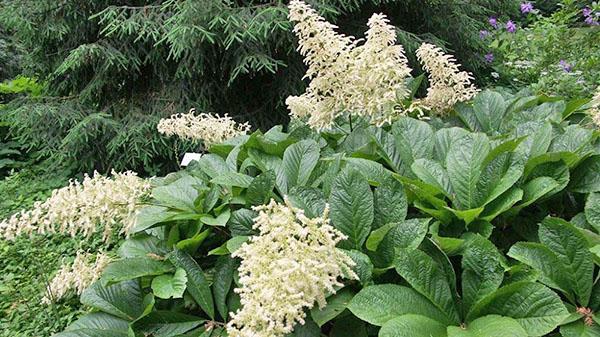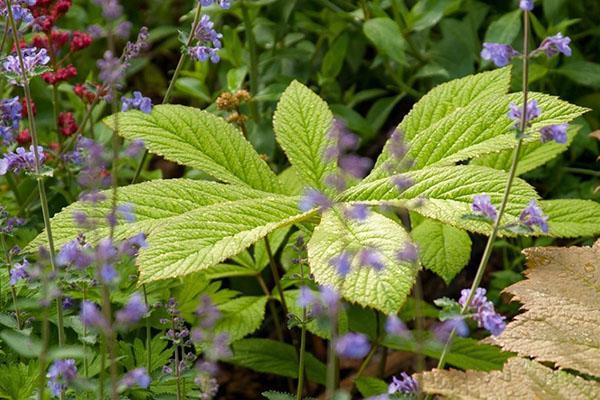The way to create exotic on the site - growing Rogers
 The elite beauty, originally from the Far East, has long won the hearts of our compatriots. Therefore, today the cultivation of Rogers is a great opportunity to create an exotic paradise near your home. The plant harmoniously fits into the country landscape, and its massive foliage is simply irresistible. What does a dear guest from a distant land look like? Let's open the curtain of its attractiveness.
The elite beauty, originally from the Far East, has long won the hearts of our compatriots. Therefore, today the cultivation of Rogers is a great opportunity to create an exotic paradise near your home. The plant harmoniously fits into the country landscape, and its massive foliage is simply irresistible. What does a dear guest from a distant land look like? Let's open the curtain of its attractiveness.
Biological features

In its natural environment, the flower grows in open glades of humid forests, where light falls in the morning and at sunset. It can be seen in the coastal area of freshwater lakes or rivers. In addition to China, Japan and Korea are considered the birthplace of Rogers.
The culture has powerful pivotal roots, on which horizontal shoots grow over the years. From them, erect shoots are formed, turning the flower into a voluminous shrub up to about 1.5 m high.
 The main advantage of Rogers is its large massive foliage. It can be pinnate or finger-like. It resembles chestnut leaves in shape. The diameter of the plate is about 50 cm. It is located on long and compacted petioles. The surface is colored bright green or reddish, which can change throughout the season.
The main advantage of Rogers is its large massive foliage. It can be pinnate or finger-like. It resembles chestnut leaves in shape. The diameter of the plate is about 50 cm. It is located on long and compacted petioles. The surface is colored bright green or reddish, which can change throughout the season.
Flowering culture begins in mid-summer (July) and continues until early August. At this time, original paniculate inflorescences rise above the lush crown of massive foliage.
They consist of a huge number of small buds, which are:
- snow-white;
- pinkish;
- beige;
- greenish color.
 The inflorescences exude a delicate odor that attracts all kinds of insects.
The inflorescences exude a delicate odor that attracts all kinds of insects.  When they are pollinated and wither, fruits are set. Over time, in their place, seeds are formed in the form of miniature stars. After that, the plant actively throws out new leaf plates. Thus, it adorns the landscape of the summer cottage all season.
When they are pollinated and wither, fruits are set. Over time, in their place, seeds are formed in the form of miniature stars. After that, the plant actively throws out new leaf plates. Thus, it adorns the landscape of the summer cottage all season.
The plant is not afraid of deep shade, so it is grown even among tall trees or shrubs of the garden.
Growing Rogers: practical advice from professionals
 To create a cozy recreation areaoften use unique cultures. Unfortunately, many exotic plants are very capricious and require special care. Therefore, the effort spent leads to a sad outcome. However, growing Rogers brings true satisfaction to many. The main thing is to take the matter seriously and follow the guidance of professionals.
To create a cozy recreation areaoften use unique cultures. Unfortunately, many exotic plants are very capricious and require special care. Therefore, the effort spent leads to a sad outcome. However, growing Rogers brings true satisfaction to many. The main thing is to take the matter seriously and follow the guidance of professionals.
A wise approach to choosing a suitable site
 To achieve success in creating a piece of paradise on the territory of a country house, first of all, you need to find a suitable place. Since the culture is found naturally on forest edges and among shrubs, it is best suited for a shaded area of the garden or partial shade. She extremely dislikes when the scorching sun shines on her all day, burning sheet plates.
To achieve success in creating a piece of paradise on the territory of a country house, first of all, you need to find a suitable place. Since the culture is found naturally on forest edges and among shrubs, it is best suited for a shaded area of the garden or partial shade. She extremely dislikes when the scorching sun shines on her all day, burning sheet plates.  The site should be away from drafts so that the flower does not suffer from frost in the cold season.
The site should be away from drafts so that the flower does not suffer from frost in the cold season.
Considering that an adult Rogers can reach 100 cm in diameter, it needs to be provided with enough space initially. The best option is to plant the crop at a distance of 1.2 m from neighboring plants.
Reproduction methods

When a place for an exotic beauty is found, they start planting and caring for a Rogers. The culture is propagated in three ways:
- seeds;
- by dividing the bush;
- using cuttings.
 To grow a flower by sowing seeds requires patience. They are sown in autumn using containers with fertile soil. The planting material is lowered into grooves up to 2 cm deep and covered with earth. The boxes are placed in the courtyard under a canopy so that rain does not fall on them. They stay there for about 21 days. After that, the containers are transferred to a room where the temperature does not rise above 15 ° C. After 2 weeks, the first shoots will appear.
To grow a flower by sowing seeds requires patience. They are sown in autumn using containers with fertile soil. The planting material is lowered into grooves up to 2 cm deep and covered with earth. The boxes are placed in the courtyard under a canopy so that rain does not fall on them. They stay there for about 21 days. After that, the containers are transferred to a room where the temperature does not rise above 15 ° C. After 2 weeks, the first shoots will appear.
When they grow up to 10 cm in height, they are dived into separate pots or small containers. In the spring, the seedlings are exposed to the street, but they are planted in a permanent place only at the beginning of September.
The culture grown in this way will bloom after about 3 or 4 years.
If there is at least one Rogers in the flowerbed, it is propagated by dividing the bush.  It is best done in the spring when the plant needs rejuvenation. For this, the culture is dug out of the flower bed and freed from the ground. Then the rhizome is cut into pieces so that each has full elements for growth. The seedlings are planted directly into the open ground, where they take root and turn into a lush green ball by autumn.
It is best done in the spring when the plant needs rejuvenation. For this, the culture is dug out of the flower bed and freed from the ground. Then the rhizome is cut into pieces so that each has full elements for growth. The seedlings are planted directly into the open ground, where they take root and turn into a lush green ball by autumn.
The procedure can be carried out in the fall. But the plant is first planted in containers with fertile soil, where they are until spring.
 A fairly simple way to plant and care for Rogers outdoors is to use cuttings. They are cut during the summer and placed in pots of fertile soil. When the cutting takes root, it is planted in a flower bed.
A fairly simple way to plant and care for Rogers outdoors is to use cuttings. They are cut during the summer and placed in pots of fertile soil. When the cutting takes root, it is planted in a flower bed.
To preserve the uniqueness of the type of crop, it is better to plant only one variety on one site.
Meet the popular types of exotic beauty
 Since Rogersia looks luxurious on the territory of the summer cottage, it is grown together with ferns, hosts and coniferous shrubs. There are a huge number of species of exotic overseas beauty, which have their own unique differences. Let's consider the most popular ones.
Since Rogersia looks luxurious on the territory of the summer cottage, it is grown together with ferns, hosts and coniferous shrubs. There are a huge number of species of exotic overseas beauty, which have their own unique differences. Let's consider the most popular ones.
Rogers feathery
 Lush bushes of the plant grow up to 60 cm, therefore they are considered a stunted species. Leaf plates resemble rowan in shape. They are painted green with scarlet streaks. Paniculate inflorescences of Rogersia pinnate are pale pink or creamy.
Lush bushes of the plant grow up to 60 cm, therefore they are considered a stunted species. Leaf plates resemble rowan in shape. They are painted green with scarlet streaks. Paniculate inflorescences of Rogersia pinnate are pale pink or creamy.
There are several varieties of this type:
- Borodin (distinguished by snow-white buds);
- Alba (flowers are cream or yellowish);
- "Superba" (large pink inflorescences with red-edged leaf blades).
Rogersia feathery elegans
 Differs in pale pink inflorescences, which are collected in a brush. Finger-lobed dark green leaf plates are located on elongated petioles. The bush grows up to 75 cm. Prefers places with scattered penumbra.
Differs in pale pink inflorescences, which are collected in a brush. Finger-lobed dark green leaf plates are located on elongated petioles. The bush grows up to 75 cm. Prefers places with scattered penumbra.
Rogersia Chocolate Wings
 This plant is considered the most common ornamental variety. The secret of its appeal is the chocolate brown colored leaf plates. It is interesting that in July they acquire a bronze or greenish tint. They are an exotic decoration for any landscape.
This plant is considered the most common ornamental variety. The secret of its appeal is the chocolate brown colored leaf plates. It is interesting that in July they acquire a bronze or greenish tint. They are an exotic decoration for any landscape.
Proper planting and caring for Rogers Chocolate Wings includes:
- timely watering;
- regular weeding of the soil;
- during drought - spraying;
- planned fertilization.
Adhering to these rules, it is quite easy to grow an overseas beauty on the territory of a summer cottage.
Rogers feathery "Pinnata"

The plant perfectly tolerates Russian winters. However, it requires special preparation. In the fall, remove from the bushes:
- peduncles;
- dried shoots;
- leftover foliage.
In regions where winters are particularly harsh, culture needs additional shelter. It is made from spruce branches, fallen leaves or straw.
In winter, the plant is additionally covered with fallen snow, which is thrown directly onto the bush.
Rogersia chestnut
 The maximum growth of a crop is about 180 cm. Its foliage resembles chestnut plates. It is large in size. They are painted bright green. In the spring and in the autumn, bronze-colored stains appear on them. During flowering, dense and lush panicles appear on Rogers cones. They consist of many snow-white or light pink buds that adorn the bush for 4 weeks. The plant is grown in gardens located near a natural or artificial reservoir.
The maximum growth of a crop is about 180 cm. Its foliage resembles chestnut plates. It is large in size. They are painted bright green. In the spring and in the autumn, bronze-colored stains appear on them. During flowering, dense and lush panicles appear on Rogers cones. They consist of many snow-white or light pink buds that adorn the bush for 4 weeks. The plant is grown in gardens located near a natural or artificial reservoir.
 A common subspecies of culture is the Rogers of Henrici Cherry Blush. It tolerates direct sunlight well. In early spring, its foliage has a milky-coffee hue. In the summer, it takes on a bright green saturated color. Such exotic changes contribute to the active use of culture in the creation of spectacular landscape design. In addition, planting and caring for Rogers chestnut leaves does not require special skills and efforts. the main thing water regularly plant, fertilize and do scheduled pruning.
A common subspecies of culture is the Rogers of Henrici Cherry Blush. It tolerates direct sunlight well. In early spring, its foliage has a milky-coffee hue. In the summer, it takes on a bright green saturated color. Such exotic changes contribute to the active use of culture in the creation of spectacular landscape design. In addition, planting and caring for Rogers chestnut leaves does not require special skills and efforts. the main thing water regularly plant, fertilize and do scheduled pruning.
If the region usually experiences severe frosts in winter, it is advisable to arrange additional shelter for the plant.
Rogersia
 The uniqueness of the variety lies in the resistance of the perennial to droughts. Despite this, the bush grows up to 1.5 m in height. Rogers' leaf plates have a glossy surface and are painted in bronze. In summer, the bush is decorated with pretty inflorescences, consisting of many pinkish buds with a "glamorous" green tint.
The uniqueness of the variety lies in the resistance of the perennial to droughts. Despite this, the bush grows up to 1.5 m in height. Rogers' leaf plates have a glossy surface and are painted in bronze. In summer, the bush is decorated with pretty inflorescences, consisting of many pinkish buds with a "glamorous" green tint.
Rogersia esculifolia
 The flower grows up to 60 cm, which looks spectacular in the summer cottage. During the flowering period, it reaches 120 cm. The bush is decorated with pinnately divided foliage, which keeps on long petioles (from 40 to 100 cm). In early spring, it is colored purple. And in the summer they take on a dark green hue.
The flower grows up to 60 cm, which looks spectacular in the summer cottage. During the flowering period, it reaches 120 cm. The bush is decorated with pinnately divided foliage, which keeps on long petioles (from 40 to 100 cm). In early spring, it is colored purple. And in the summer they take on a dark green hue.
Rogersia esculifolia blooms for about 25 days in lush bouquets covered with pink or snow-white buds.
Rogers Elderberry
 This variety has appeared relatively recently, therefore it is extremely rarely used in the garden landscape. It is distinguished by large feathery leaf plates, which are painted in a bright bronze color. In early July, Rogers Elderberry wears a dazzling outfit of snow-white inflorescences. The culture grows up to 70 cm, and with peduncles exceeds 100 cm in height. Some subspecies have cream-colored buds.
This variety has appeared relatively recently, therefore it is extremely rarely used in the garden landscape. It is distinguished by large feathery leaf plates, which are painted in a bright bronze color. In early July, Rogers Elderberry wears a dazzling outfit of snow-white inflorescences. The culture grows up to 70 cm, and with peduncles exceeds 100 cm in height. Some subspecies have cream-colored buds.
Rogersia Dark Poker
 Perennial is distinguished by large leaf plates of palmate-lobed shape of green color with a pink frame. Lush inflorescences have a slightly creamy shade. The culture develops well in the shaded areas of the garden. However, Rogers Dark Poker does not like drafts and strong winds. The variety is propagated by dividing the bush or by seeds. They are actively used to decorate the suburban area.
Perennial is distinguished by large leaf plates of palmate-lobed shape of green color with a pink frame. Lush inflorescences have a slightly creamy shade. The culture develops well in the shaded areas of the garden. However, Rogers Dark Poker does not like drafts and strong winds. The variety is propagated by dividing the bush or by seeds. They are actively used to decorate the suburban area.
 Having considered the unique charms of Rogers, you will probably want to grow it in your summer cottage. The culture is unpretentious, not afraid of cold weather. Fits wonderfully into the countryside landscape. The variety of types allows you to choose the right option for yourself in order to create a cozy corner for relaxation.
Having considered the unique charms of Rogers, you will probably want to grow it in your summer cottage. The culture is unpretentious, not afraid of cold weather. Fits wonderfully into the countryside landscape. The variety of types allows you to choose the right option for yourself in order to create a cozy corner for relaxation.